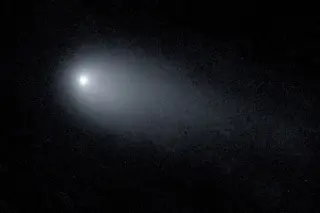In September, astronomers announced the discovery of the first interstellar comet known to have visited our solar system. Named 2I/Borisov after its Ukrainian discoverer, the comet has an extremely extended orbit — a telltale sign that its origin is from outside our solar system, beyond the sun's influence.
In the months since, astronomers have been measuring the comet’s every move as it heads toward perihelion — the point in its orbit closest to the sun. It should make that approach in early December. By studying Borisov’s movement, brightness and chemical makeup, scientists have found it’s not that different from comets in our own solar system. And that may also mean it could make a dramatic spectacle as it nears the sun.
Here’s a recap of what astronomers have discovered to date, and what to look out for in the coming weeks.
‘Oumuamua, the first known interstellar visitor, is seen venting ...














